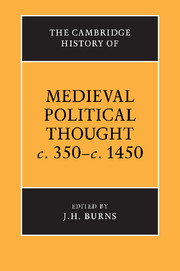Book contents
- Frontmatter
- Introduction
- I Foundations
- II Byzantium
- III Beginnings: c. 350–c. 750
- IV Formation: c. 750–c. 1150
- V Development: c. 1150–c. 1450
- 13 Introduction: politics, institutions and ideas
- 14 Spiritual and temporal powers
- 15 Law
- 16 Government
- 17 Community
- I Community, counsel and representation
- II The conciliar movement
- 18 The individual and society
- 19 Property and poverty
- Conclusion
- Biographies
- Bibliography
- Index of names of persons
- Index of subjects
- References
II - The conciliar movement
from 17 - Community
Published online by Cambridge University Press: 28 March 2008
- Frontmatter
- Introduction
- I Foundations
- II Byzantium
- III Beginnings: c. 350–c. 750
- IV Formation: c. 750–c. 1150
- V Development: c. 1150–c. 1450
- 13 Introduction: politics, institutions and ideas
- 14 Spiritual and temporal powers
- 15 Law
- 16 Government
- 17 Community
- I Community, counsel and representation
- II The conciliar movement
- 18 The individual and society
- 19 Property and poverty
- Conclusion
- Biographies
- Bibliography
- Index of names of persons
- Index of subjects
- References
Summary
The conciliar movement of the late fourteenth and early fifteenth centuries was an attempt to modify and limit papal control over the Church by means of general councils. It was sparked off by the disputed papal election of 1378, when, following the return of the papacy from Avignon to Rome, French cardinals rejected the election of the Italian Urban VI, on canonical grounds, and elected Clement VII as anti-pope. The movement was also a response to growng centralisation of church administration and justice, to perceived abuses of power by the (in fact rather weak) papacy in exile at Avignon (1305–77) and to the widespread desire for church reform. There was, further, a latent contradiction in church tradition between the doctrinal authority of councils and the jurisdictional primacy of Rome. The movement was led mostly by Frenchmen and Germans; it evoked little response in Italy. Conciliarism was a moderate programme in comparison with the aspirations of men like Marsilius, Wyclif or Hus, who wanted national or state churches, and who saw whole aspects of Catholic tradition, especially papal authority, as fundamentally opposed to scripture or to reason. But it also reflected a shift in religious sentiment from universality to nationality, and a sense that religious matters could legitimately be debated, at least by all educated clergy. In the event, the pope–council conflict affected considerably the structure of medieval Christendom. What emerged as the practical alternative to papal centralisation was devolution of power to secular rulers and nation-states.
- Type
- Chapter
- Information
- The Cambridge History of Medieval Political Thought c.350–c.1450 , pp. 573 - 587Publisher: Cambridge University PressPrint publication year: 1988
References
- 3
- Cited by

